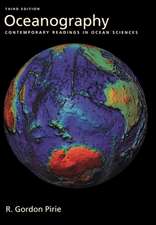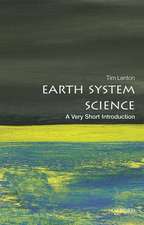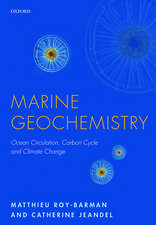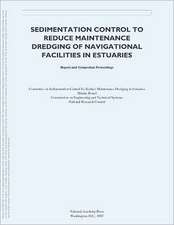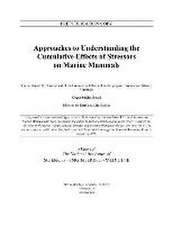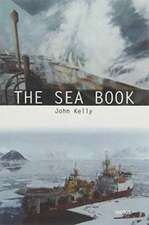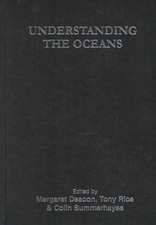Oceans: An Illustrated Reference
Autor Dorrik Stowen Limba Engleză Hardback – 21 apr 2006
Four billion years old, the oceans formed as the Earth's scorching surface cooled, the primordial atmosphere condensed, and torrential rains fell. Their color is the unique signature of our blue planet, their composition a chemical cocktail of remarkable variety, their waters a theater of constant change.
Oceans: An Illustrated Reference tells the story of this last great frontier. With hundreds of beautiful full-color photographs and explanatory diagrams, charts, and maps, Oceans combines the visual splendor of ocean life with up-to-date scientific information to provide an invaluable and fascinating resource on this vital realm. Covering all major areas of oceanographic knowledge and research, Oceans is divided into two parts. The first, "Ocean Systems," examines the physical nature of the oceans, including plate tectonics, temperature and climate, waves and tides, natural resources and much more. The second, "Ocean Life,"explores biodiversity, evolution and adaptation, marine ecosystems and complex communities, and the preservation of fragile marine environments.
Oceans also offers readers a host of tools to better understand the magnificent world of the sea. A special section of bathymetric maps-made possible by satellite observation, deep-towed surveying craft, and remotely operated submarine vessels-provides a view of the depth and texture of ocean floors around the globe, giving us a glimpse of worlds rarely seen. And throughout the book, engagingly written special features delve into specific marine environments and phenomena such as the lost Tethys Ocean, from which the Himalayas were born. Cross-references and a detailed index help readers navigate this multifaceted volume, and a glossary provides clear definitions of scientific vocabulary.
Although the oceans are vast, their resources are finite. Oceans clearly presents the future challenge to us all-that of ensuring that our common ocean heritage is duly respected, wisely managed, and carefully harnessed for the benefit of the whole planet. Lavishly illustrated and filled with current research, Oceans is a step in that direction: a rich, magnificent, and illuminating volume for anyone who has ever heard the siren song of the sea.
Oceans: An Illustrated Reference tells the story of this last great frontier. With hundreds of beautiful full-color photographs and explanatory diagrams, charts, and maps, Oceans combines the visual splendor of ocean life with up-to-date scientific information to provide an invaluable and fascinating resource on this vital realm. Covering all major areas of oceanographic knowledge and research, Oceans is divided into two parts. The first, "Ocean Systems," examines the physical nature of the oceans, including plate tectonics, temperature and climate, waves and tides, natural resources and much more. The second, "Ocean Life,"explores biodiversity, evolution and adaptation, marine ecosystems and complex communities, and the preservation of fragile marine environments.
Oceans also offers readers a host of tools to better understand the magnificent world of the sea. A special section of bathymetric maps-made possible by satellite observation, deep-towed surveying craft, and remotely operated submarine vessels-provides a view of the depth and texture of ocean floors around the globe, giving us a glimpse of worlds rarely seen. And throughout the book, engagingly written special features delve into specific marine environments and phenomena such as the lost Tethys Ocean, from which the Himalayas were born. Cross-references and a detailed index help readers navigate this multifaceted volume, and a glossary provides clear definitions of scientific vocabulary.
Although the oceans are vast, their resources are finite. Oceans clearly presents the future challenge to us all-that of ensuring that our common ocean heritage is duly respected, wisely managed, and carefully harnessed for the benefit of the whole planet. Lavishly illustrated and filled with current research, Oceans is a step in that direction: a rich, magnificent, and illuminating volume for anyone who has ever heard the siren song of the sea.
Preț: 509.38 lei
Nou
Puncte Express: 764
Preț estimativ în valută:
97.48€ • 101.19$ • 81.28£
97.48€ • 101.19$ • 81.28£
Carte indisponibilă temporar
Doresc să fiu notificat când acest titlu va fi disponibil:
Se trimite...
Preluare comenzi: 021 569.72.76
Specificații
ISBN-13: 9780226776644
ISBN-10: 0226776646
Pagini: 256
Ilustrații: Illustrated in color throughout
Dimensiuni: 229 x 305 x 25 mm
Greutate: 1.45 kg
Editura: University of Chicago Press
Colecția University of Chicago Press
ISBN-10: 0226776646
Pagini: 256
Ilustrații: Illustrated in color throughout
Dimensiuni: 229 x 305 x 25 mm
Greutate: 1.45 kg
Editura: University of Chicago Press
Colecția University of Chicago Press
Notă biografică
Dorrik Stow is professor of ocean and earth science at the Southampton Oceanography Centre, Europe's leading center for ocean research. A world-renowned oceanographer and marine geoscientist who specializes in the deep sea, Stow has published numerous books, papers, and edited volumes. He has also sailed all the world's major oceans.
Cuprins
Preface
Introduction
The Ocean Frontier
The Lure of the Sea
Great Voyages of Discovery
Pioneers of Ocean Science
Modern Oceanographic Research
Ocean Systems
Ocean Systems
1. Plates on the Move
The Ocean Planet
Plate Tectonics and Time
Backbone of the Oceans
Collision and Slippage
Oceans of the Past
2. Patterns & Cycles
From Peak to Trough
Where Land Meets Sea
Patterns on the Seafloor
Canyons, Slopes, and Fans
Islands in Time
3. Salt, Sun, & Sea Level
3. Salt, Sun, & Sea Level
Why the Sea Is Salt
Heat, Light, and Sound
Ocean Layers
Sea Level Rise and Fall
4. Silent, Swift, & Strong
Riding the Waves
Rhythm of the Tides
Great Surface Currents
Silent Cycles of the Deep
Oceans and Climate
5. Hidden Riches of the Ocean
Oil and Gas
Renewable Marine Energy
Minerals from the Sea
Ocean Maps
The Ocean Floor
The Atlantic Ocean
The Indian Ocean
The Pacific Ocean
The Polar Oceans
Ocean Life
6. Evolution & Extinction
Ocean Life
6. Evolution & Extinction
Life Unfolds
March through Time
Mass Extinction
7. The Web of Life
The Diversity of Life
Cycles, Webs, and Flows
The World of Phytoplankton
The Zooplankton
Algal Forests
8. Marine Lifestyles
The Marine Environment
Movement Underwater
Heightened Senses
Making a Living
Sexual Encounters
9. Complex Communities
Marine Habitats
Shoreline Communities
Wetlands
Coral Reefs
The Open Ocean
The Deep-Sea Floor
10. Fragile Environments
The Living Resource
Marine Pollution
Habitat Destruction
Conclusion
Future Challenge
Climate Change
A New Global Awareness
Our Common Heritage
Glossary
Further Reading
Picture Credits
Index
Recenzii
"This authoritative reference work presents a thorough overview of the physical, geological, chemical, and biological properties of the world's oceans."—Library Journal
“Beautiful. . . . A skillfully written, current, and unusually attractive presentation of ocean science that does not talk down to the audience, that unapologetically uses genus names and the SI system of measurements, and that maintains a balance between the living and non-living aspects of the ocean world. . . . . Stow has integrated contributions from experts in interlocking fields to produce a book that accomplishes the near-impossible: It could be used as a text (it has a useful glossary and index); it could grace anyone’s coffee table (the cover photo demands one pick up the book); it could sit happily on a reference shelf (where its charts and tables would be in considerable demand).”
"The pictures are glorious, lush, and thought-provoking. . . . A truly wondrous book that is engagingly written and filled with current research."
"Stow's book deserves an embarrassing amount of praise. Magnificently designed, Oceans is a reference book that offers clearly written text that is never upstaged by the book's many illustrations, photographs, high-definition imagery, diagrams, drawings, and charts. . . . An essential book that captures the latest in ocean science and turns it into interesting and comprehensible prose."
"The writing is clear, nontechnical, and intended for broad audiences, but is also intelligent and loaded with useful and interesting information. The volume is very nicely illustrated with maps, photographs, paintings, charts. . . . Clear and beautiful images visually explain generalizable themes. . . . The book would be ideal as a gift for sailors, fishers, and anyone interested in the sea. . . . This is a book I would have loved as a student in high school or as an undergraduate. But I can still learn a lot from its pages."
“In Oceans, Dorrik Stow mixes full-color photographs with encyclopedic entries covering ever aspect of the world’s seas from their origins during the Earth’s formation, to their tides and currents, to the sea life now under threat from overfishing in so many locales. A solid reference for the mariner, real or imagined, in your life.”
"With the full-colour illustrtions and explanatory diagrams, the text is at a very readable level for the layperson, and most marine researchers could benefit from its inbtroduction to disciplines other than their own. I also feel that many of the diagrams and tables would be useful as introductory teaching tools at high school or early university level."
Descriere
Descriere de la o altă ediție sau format:
The importance of the oceans to life on Earth cannot be overstated. Liquid water covers more than 70% of our planet's surface and, in past geological time, has spread over 85%. Life on Earth began in the oceans over 3.5 billion years ago and remained there for the great majority of that time. Today the seas still provide 99% of habitable living space, the largest repository of biomass, and holds the greatest number of undiscovered species on the planet. Our oceans are vital for the regulation of climate, and with global warming and decreasing land area, they have become increasingly important as the source of food, energy in the form of oil and gas, and for their mineral wealth. Oceans also form a key part of the biogeochemical cycles of carbon, nitrogen, and other elements critical to life. Nutrients in upwelling areas are spread by ocean currents, and the plankton of the seas supports a wealth of wildlife. In this Very Short Introduction Dorrik Stow analyses these most important components of our blue planet and considers their relationship with, and exploitation by, humans. He shows how the oceans are an essential resource to our overpopulated world, and discusses why exploration and greater scientific understanding of the oceans, their chemistry, and their mineral wealth are now a high priority. Stow also explores what we know of how oceans originate, and evolve and change; the shape of the seafloor and nature of its cover; the physical processes that stir the waters and mix such a rich chemical broth; and the inseparable link between oceans and climate. As polar ice melts and sea-levels rise, countless millions who have made their homes on low-lying lands close to the sea are threatened. As scientific exploration of the seas gathers pace, the new knowledge gained of the ocean-Earth systems and their interaction with the human environment is vital to our understanding of how we can preserve these ultimately fragile environments.ABOUT THE SERIES: The Very Short Introductions series from Oxford University Press contains hundreds of titles in almost every subject area. These pocket-sized books are the perfect way to get ahead in a new subject quickly. Our expert authors combine facts, analysis, perspective, new ideas, and enthusiasm to make interesting and challenging topics highly readable.
The importance of the oceans to life on Earth cannot be overstated. Liquid water covers more than 70% of our planet's surface and, in past geological time, has spread over 85%. Life on Earth began in the oceans over 3.5 billion years ago and remained there for the great majority of that time. Today the seas still provide 99% of habitable living space, the largest repository of biomass, and holds the greatest number of undiscovered species on the planet. Our oceans are vital for the regulation of climate, and with global warming and decreasing land area, they have become increasingly important as the source of food, energy in the form of oil and gas, and for their mineral wealth. Oceans also form a key part of the biogeochemical cycles of carbon, nitrogen, and other elements critical to life. Nutrients in upwelling areas are spread by ocean currents, and the plankton of the seas supports a wealth of wildlife. In this Very Short Introduction Dorrik Stow analyses these most important components of our blue planet and considers their relationship with, and exploitation by, humans. He shows how the oceans are an essential resource to our overpopulated world, and discusses why exploration and greater scientific understanding of the oceans, their chemistry, and their mineral wealth are now a high priority. Stow also explores what we know of how oceans originate, and evolve and change; the shape of the seafloor and nature of its cover; the physical processes that stir the waters and mix such a rich chemical broth; and the inseparable link between oceans and climate. As polar ice melts and sea-levels rise, countless millions who have made their homes on low-lying lands close to the sea are threatened. As scientific exploration of the seas gathers pace, the new knowledge gained of the ocean-Earth systems and their interaction with the human environment is vital to our understanding of how we can preserve these ultimately fragile environments.ABOUT THE SERIES: The Very Short Introductions series from Oxford University Press contains hundreds of titles in almost every subject area. These pocket-sized books are the perfect way to get ahead in a new subject quickly. Our expert authors combine facts, analysis, perspective, new ideas, and enthusiasm to make interesting and challenging topics highly readable.



